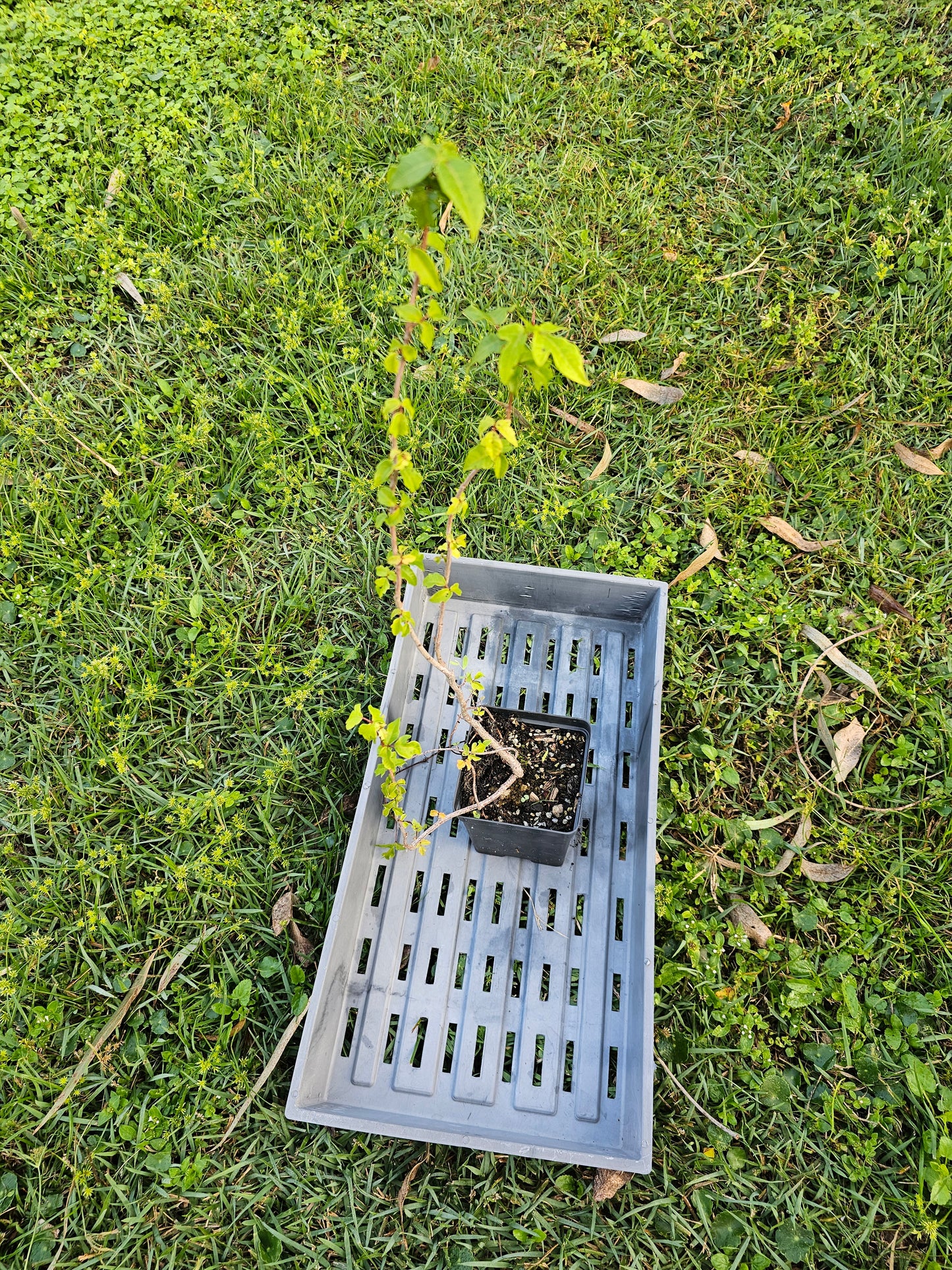Gnarly Nursery
Toxicodendron radicans, Poison Ivy
Toxicodendron radicans, Poison Ivy
Out of stock
Couldn't load pickup availability
Toxicodendron radicans
Common Name(s):
Previously known as:
Phonetic Spellingtoks-ee-ko-DEN-dron RAD-ee-kans
This plant has high severity poison characteristics. See below
Description
Poison ivy is native throughout the United States and much of southern Canada and can be found in a wide variety of locations including dry or wet woodlands, thickets, valleys, clearings, fence rows, roadsides and waste ground. It can appear as a bushy, erect or trailing shrub in sunny areas or as a woody climbing vine. The climbing vines have aerial rootlets. All parts of the plant contain a toxic oil called urushiol that can cause significant and long-lasting skin irritations (allergic dermatitis) in most human beings. Infection can occur from direct contact with the plant, indirect contact (e.g., dog, rake or shoes) or from breathing smoke from a fire of plant material. Some humans seem to be immune.
When it grows as a woody shrub, it can reach lengths of 6 feet; when it grows as a vine, it can reach 60 to 150 feet tall and climb high on trees, walls, and fences or trail along the ground. Birds, reptiles, deer, and amphibians can eat the plant and its berries and also use the plant as shelter. A variety of insects feed on the flowers of poison ivy too – from beetles to flies, bees, wasps, ants, and butterflies. Due to its wildlife benefits, it can be left alone in areas with low human activity.
Poison ivy leaves are compound leaflets in groups of three, a trait that can reliably distinguish it from a number of similar native vines. The middle leaflet is longer than the outer two. It’s hard to describe poison ivy leaflets because their shape and size vary from smooth, rounded edges to serrated edges to shallowly lobed edges, but its leaflets are always in groups of three. Poison ivy leaves are shiny, bright green, and turn an attractive red or reddish yellow in the fall. The bark is dark gray and densely covered in aerial roots.
Poison ivy can be removed by either mechanical means– such as repeated mowing or pulled with gloved hands– or with certain herbicides applied to freshly cut stumps. Only use herbicide as a last resort.
- Insects, Diseases, or Other Plant Problems:
- Poison ivy, is the ultimate weed that no one wants. As the saying goes, “Leaflets three, let it be. "Do not touch any part of a poison ivy plant. All parts of the plant contain volatile oils that can cause significant skin irritation on direct or indirect contact. Do not burn plant materials because contact with smoke from the burning materials can be just as toxic as touching the plants, and breathing that smoke can be even more hazardous.
- Genus:
- Toxicodendron
- Species:
- radicans
- Family:
- Anacardiaceae
- Life Cycle:
- Perennial
- Woody
- Recommended Propagation Strategy:
- Seed, Cuttings
- Distribution:
- All United States except Hawaii, California, and Alaska
- Wildlife Value:
- Although this plant can cause severe skin irritations on some people, the fruits are readily eaten by songbirds and woodpeckers. White-tailed deer and rabbits browse the plant and reptiles and amphibians use it for shelter. The flowers are pollinated by and act as a food source for a wide variety of insects.
- Wildlife Value:
- Wildlife Cover/Habitat
- Wildlife Food Source
Whole Plant Traits:
- Light:
- Dappled Sunlight (Shade through upper canopy all day)
- Full sun (6 or more hours of direct sunlight a day)
- Partial Shade (Direct sunlight only part of the day, 2-6 hours)
- Soil Texture:
- Clay
- High Organic Matter
- Loam (Silt)
- Sand
- Shallow Rocky
- Soil pH:
- Acid (<6.0)
- Alkaline (>8.0)
- Neutral (6.0-8.0)
- Soil Drainage:
- Moist, Occasionally Dry
- USDA Plant Hardiness Zone:
- 4a, 4b, 5a, 5b, 6a, 6b, 7a, 7b, 8a, 8b, 9a, 9b, 10a, 10
- Fruit Description:
- Each flower is replaced by a drupe that contains a single seed (stone). This drupe is dull white and about ¼ inch across; it has a smooth waxy surface. The large seed is ovoid in shape and dull white; there are a few grey stripes across its surface. The drupes mature during the fall and can persist through the winter.
- Contact Dermatitis
- Weedy
Poisonous to Humans:
- Poison Severity:
- High
- Poison Symptoms:
- All parts of poison-ivy contain resinous compounds called urushiols, the highest concentrations in the leaves and bark as well as younger leaves. When urushiols directly come into contact with the skin or are inhaled via smoke, they cause inflammation, itching, and blistering. The skin irritation is significant and long-lasting for most humans.
- Poison Toxic Principle:
- Urushiol
- Causes Contact Dermatitis:
- Yes
- Poison Part:
- Bark
- Flowers
- Fruits
- Leaves
- Roots
- Sap/Juice
- Seeds
- Stems
Share

